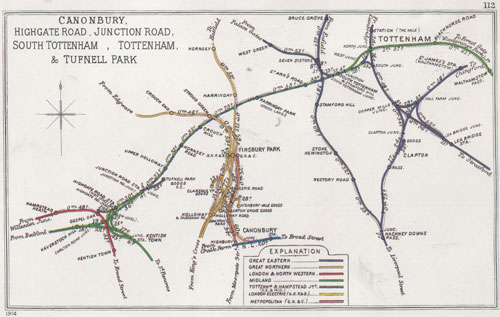|
| OO Scale | N Scale | G Scale | Z Scale | HO Scale | Slot Cars & R⁄C |
| |||||||
|
|||||||
| Home Page | |||||||
| BUY GIFT VOUCHERS | |||||||
| Products | |||||||
| Latest News | |||||||
| RIGHT LINES | |||||||
| Bargains | |||||||
| Downloads | |||||||
| Events | |||||||
| Careers & Jobs | |||||||
| Carriage Services | |||||||
| About Us | |||||||
| Contact Us | |||||||
| Pay Us A Visit | |||||||
| Meet The Staff | |||||||
| Links | |||||||
| SHOPPING BASKET |
Your shopping basket is empty. To add an item, click the "Buy" button
| YOUR ACCOUNT | ||
|
||||
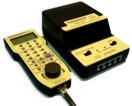 |
||||
| Prodigy Advance Digital System |
||||
| Cased Controllers |
||||
| Panel Mount Controllers |
||||
| Walkabout Controllers |
||||
| Modules & Transformers |
||||
| Scenics & Accessories |
||||
| Wiring & Electrical Components |
||||
| Tiny Signs | ||||
| Tools | ||||
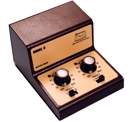 |
||||
| RECENTLY VIEWED |
| MODELSTRIP - Use GM08 |
| O Scale | Wargaming | Architectural | Narrow Gauge | Tools+ | ||
The GER L77/LNER N7: London Suburban Lines and Beyond

STUART JORDAN looks at the history of this long-serving tank locomotive.
Alfred John Hill became an apprentice at the Great Eastern Railways (GER) Stratford Works in 1877, and rose through the ranks to become GER Chief Mechanical Engineer in 1912. Despite being restricted by the outbreak of World War I, Hill was able to improve the works by building a new foundry and engine repair shop at Stratford (later the site of Stratford International).
1914 map of part of the suburban routes in London, including GER lines. (click for larger image)
At this time the GER ran services between Liverpool Street Station and Norwich, other services in East Anglia, and London Suburban services. In 1902 the GER rejected the option of electrifying the Suburban routes, so other alternatives were explored to haul the heavy passenger loads between the frequent stops on the lines around London. Hill’s answer was the 0-6-2T L7 Class Tank Locomotive; its small wheels meant that it could accelerate quickly, and it was heavier than the previously used 2-4-2Ts and 0-4-4Ts giving more traction for the same amount of axles.
Hill built the first two L77 locomotives in 1915, experimenting with new technologies. For comparisons' sake one was fitted with a superheater, which reheats the steam – increasing thermal efficiency by stopping the steam from condensing within the heater. They were also fitted with Walschaerts valve gears, not often used in Britain at the time, which allowed the driver to manually increase the pressure on the piston to give more force when moving off from a station or ascending a gradient.
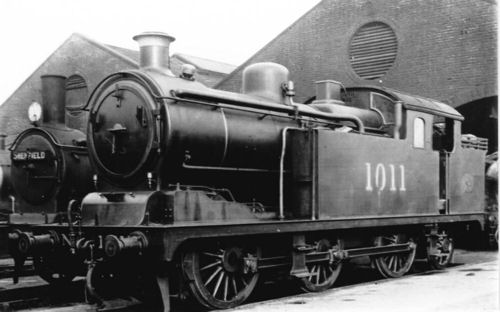
GER L77 Class 1011, one of the first batch of saturated locomotives built in 1921.
Ten non-superheated (saturated) L77 Locomotives were built in 1921, followed by ten fitted with superheaters built between 1923 and 1924. The first two built were set to work on the Enfield and Chingford lines, the next twelve working heavy suburban routes around Stratford, and the next batch were split between Stratford, West Riding and Hatfield. The four locomotives that were stationed at West Riding were later temporarily moved to Neasden to take passengers to the British Empire Exhibition at Wembley in 1924 and 1925.
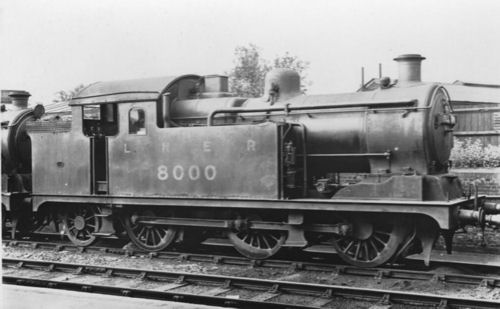
LNER N7 Class 8000. Built in 1915 this locomotive was originally numbered 1000 in the GER days, and was one of the first two built by Hill.
The London Suburban services were known as ‘Jazz trains’; nothing to do with the music genre, but the distinctive ‘jazzy’ (in the vernacular of the time) stripes on the coaches denoting class – yellow for 1st, and blue for 2nd. Originally the coaching stock was four-wheeled coaches, which were later widened and fitted with bogies.
Hill retired from the GER in 1929 when Grouping came into effect, and the Great Eastern was folded into the London North Eastern Railway (LNER). Nigel Gresley was impressed by the L77, so it continued service in the LNER, reclassified as the N7 Class. One hundred and twelve more N7s were built between 1925 and 1928 in five batches. LNER allocated these new locomotives to suburban services, evening excursions, and boat trains to the Royal Albert Docks.
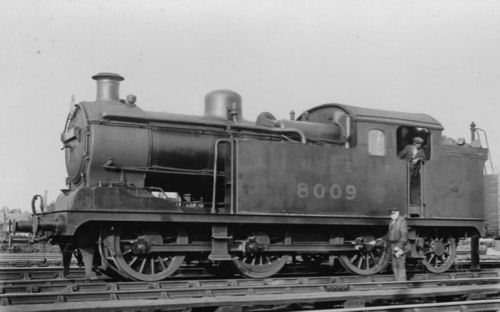
LNER N7 Class 8009.
LNER classified the N7s into six sub-classes:
- N7/GE – The original 22 GER L77 Locomotives.
- N7/1 – The first 50 LNER N7s with metropolitan loading gauge.
- N7/2 – The next 30 LNER N7s with long travel valve gears.
- N7/3 – The last 32 LNER N7s with round-top fireboxes.
- N7/4 – N7/GE locomotives rebuilt with round-top fireboxes.
- N7/5 – N7/1 locomotives rebuilt with round-top fireboxes.
After WW2 electrification of the suburban lines lead to the N7 moving out of London into East Anglia and the East of England. Four even made it as far as the Leeds-Bradford and Leeds- Castleford lines as stand-ins for DMUs. With DMUs and EMUs taking over the London traffic the N7s began to be withdrawn in the 1950s, with the last leaving service in 1962. Only one remains in preservation, no. 7999 at the East Anglia Railway Museum in late BR livery.
Models of the L77/N7 Locomotive

At time of writing (February 2017), Oxford Rail have announced that they will be producing three different versions of the L77/N7 in OO Scale; one in the original GER livery, one in LNER livery, and the third in the early BR scheme. All three are available as standard analogue or DCC Sound versions. They are due for release in the last quarter of 2017.
|
We are always looking to make improvements to our website to try and improve the quality of your visit. We would welcome your feedback and suggestions, so please do not hesitate to e-mail our webmaster with your comments. Alternatively call us on 01903 884488.
Home Cookies Privacy Statement Terms & Conditions Site Map Site Guide
WEEE Regulations Glossary Careers & Jobs
Tel – +44 (0) 1903 884488 Fax – +44 (0) 1903 884377 E-Mail us – click here
Gaugemaster.com is a trading name of Gaugemaster Controls Ltd.
Registered in England No. 2714470, Registered office:
Gaugemaster House, Ford Road
Arundel, West Sussex, BN18 0BN, United Kingdom
VAT Reg. No. 587 8089 71
Copyright © 2003-2014 Gaugemaster Controls Ltd. All Rights Reserved.

